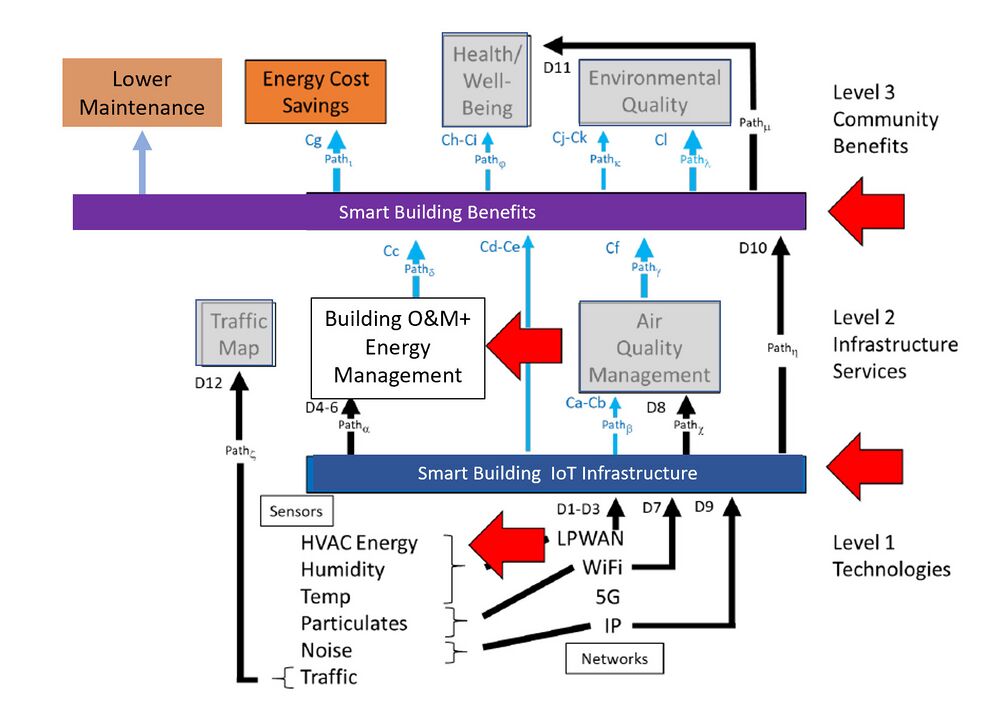Sandbox
Objective
This section explores how the next generation of smart building operations, functionality and maintenance is utilizing the (IoT) internet of things to operate at full interconnectivity, functionality and efficiency. Smart building, operations, functionality and maintenance capabilities cut energy consumption and CO2 emissions, reduce maintenance costs and extend equipment lifetime. Various systems offer actionable insights, drive fewer complaints from occupants, decrease the need for unscheduled maintenance and reduce energy costs and carbon footprint. In time of pandemic or other extreme events, smart buildings may offer autonomous operation.
For many people, the idea of a SMART building creates and implies an image of a building with complex IoT applications that can only be understood, integrated and operated by a cadre of a highly trained facility, IT, and project management professionals. A similar apprehension existed with the first generation of buildings with BAS (Building Automation System)— i.e. an intelligent system of both hardware and software, connecting heating, venting and air conditioning system (HVAC), lighting, security, and other systems to communicate on a single platform. Most larger buildings today have a BAS system for significant energy saving and operational benefits it provides.
An introduction of AI systems now expands the operational capabilities and even suggests the possibility of fully autonomously operated buildings, connecting with and responding to the signals from the grid.
Smart Building Operations
The difference between BAS and the smart, connected building operations
The difference between BAS and smart building operations is the ability to gather data, analyze and diagnose problems from multiple data input sources. Building automation systems (BAS) help facility owners conserve energy and optimize performance with controls that allow for examples like scheduling, occupancy and maintaining set-points. Smart building operations are a step ahead from this, and represent a facility's ability to gather the data and change operational outcomes accordingly. The key is data acquisition, analytics, and diagnostics.
The transition to smart operations does not have to occur all at once but can be gradual and phased. For owners with a robust, and at some levels integrated BAS in their facilities today, transitioning to a smart building environment will be easier to accomplish.
The very first step is to install smart meters that can provide near-real-time energy usage data showing energy consumption, and in some cases, at what cost. This on its own has the advantage of improving a building operator's insights to save energy, reducing the carbon footprint, improving the longevity of equipment and reducing costs. Smart meters offer utility monitoring opportunities on a more granular basis toward the conservation of our natural resources. The systematic tracking and optimization of building energy consumption with visual dashboards can also help not only to change the behavior of building occupants but also connect and make the building responsive to the price and demand signals from the grid as connected buildings. Blueprint Chapter 6 – Interfacing with City Services and Utilities provides further explanation.
The building operation KPI’s
How do we evaluate the effectiveness of the building operations? The KPI’s for the building operation are:
- Lower energy performance gap: building operation presents several inefficiencies compared to project conditions that lead to an energy performance gap. This gap can be reduced by monitoring systems.
- Lower maintenance and replacement costs: smart-ready services reduce maintenance and replacement costs since they permit to prevent or detect faults and failures.
Using the holistic H-KPI framework1, provides a more comprehensive view, enables aggregation and normalization of smart building indicators, and allows better quantification and comparison of operations in different types of buildings, The H-KPI;s use three levels: Level 1- technology, Level 2- infrastructure and level 3 – benefits.
The interactions across the three levels of analysis is a central component of the H-KPI methodology. For example, sensors deployed at Level 1 inform the building management infrastructures at Level 2. The benefits of deploying the smart controls are then manifested at level 3.
Level 1-Technologies
The first step is to install sensors to monitor building performance in real-time. Sensors provide data to a one or more processing units that uses that information to drive heating and cooling equipment as well as actuators, dampers, fans and other components to control a building's operation. They are capable of collecting environmental and operational data of buildings and reacting to the collected information in real time. They are the front end of smart building systems.
From a data standpoint, a commercial building is a complex business with diverse needs. The right combination of sensors in an integrated network is worth much more than the sum of its parts, with significant value for predictive maintenance, operational efficiency, downtime reduction, environment stabilization, and occupant comfort1. The following are the type of sensors found in smart buildings:
AHUs, chillers, and boilers all need pressure sensors to monitor pressure in ducts, condensers, and evaporators, and water supplies. High or low pressure readings are an invaluable predictor of leaks, pump failures, locked rotors, clogs, and other mechanical failures. They’ll provide proof of flow and can be used as a control point for things like fan speeds or air flow through duct work. You’ll also be able to monitor building zone pressure to regulate the inflow of outside air.
Many facilities have precise environmental humidity requirements — laboratories, libraries, manufacturing plants, et cetera — due to the materials or processes housed within them. Even in office and residential buildings, however, humidity regulation is a critical component of occupant comfort. Humidity sensors within air handling units help you determine how much outside air you need to introduce into the building and keep you timely in your response when RH is exiting the desired range.
